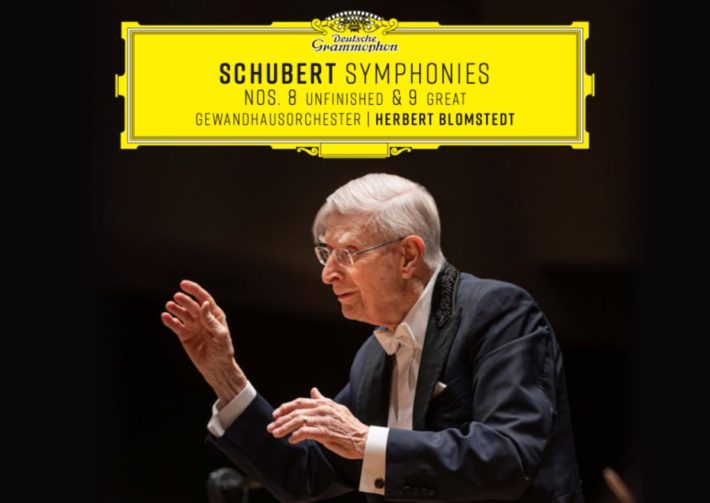This new release marks Blomstedt’s belated debut on the DG label. This is a repertoire Blomstedt has recorded multiple times: first, as part of a complete cycle recorded in Dresden in the 1980s. He recorded these two symphonies again in the 1990s with the San Francisco Symphony during his tenure as Music Director. There is also a 2016 DVD of Blomstedt leading the Danish National Symphony Orchestra in the ‘Unfinished,’ and just last year the Bavarian Radio Symphony Orchestra released a 2010 live performance of the ninth on their in-house label. All of these recordings (I have not seen the DVD) are very fine, which makes one wonder why the conductor, orchestra and/or label choose this repertoire. Do these new performances present a substantially new, or better, interpretation?
The 1980s Dresden recordings are beautifully shaped, with plenty of potent atmosphere, the Dresden orchestra’s playing consistently impressive. Nevertheless, the engineering creates a rather beefy sound, with congested textures, especially above forte. Blomstedt, using the old Schubert edition (edited by Brahms!), conducts the ninth’s slow introduction in a slow 4 – more recent scholarship has revealed Schubert intended the passage be played in cut time, which makes the transition into the Allegro flow more organically. In both symphonies there is an occasional loss of energy, sometimes resulting in a stodgy and strait-laced feel, and, in the coda of ninth’s first movement Blomstedt makes a rare interpretive misstep by taking a sizable and disruptive rallentando. He ignores the exposition repeat in the opening movement of both symphonies, honoring only a few of the repeats in the third and fourth movements of the ninth.
The San Francisco performances are more persuasive: Blomstedt’s mastery of symphonic structure is readily apparent, as is his ability to summon impassioned playing from his orchestra. Tempos are tightened and textures are more transparent. The ninth’s slow introduction is now conducted in two, with exposition repeats in the first movement of both symphonies observed (as are most repeats in the ninth). Yet there is a slightly glassy upper string sound and Decca’s engineers do not successfully mitigate the notorious acoustics of Davies Symphony Hall.These new performances are cut from the same cloth. Timings are very close: in the first movement of the Gewandhaus ‘Unfinished’ Blomstedt is a mere 6 seconds slower, while the slow movement of the ninth is about half a minute faster. But the new readings have even greater cohesion and a higher energy level. (An energy that was at times frustratingly absent from this same team’s recent Brahms cycle on Pentatone.) Blomstedt coaxes wonderfully supple playing from the Gewandhausorchester, who vividly capture the music’s mercurial shifts in emotion and mood. As good as San Francisco is, they do not rival the burnished sonic splendor in Leipzig. Listen to the intense sense of foreboding created in the opening minutes of the ‘Unfinished,’ timpani imparting a sense of darker menace. And how beautifully phrases are shaped – the ninth’s slow movement has a beguiling lyricism, the winds exceptionally touching.
Related Posts
- Review: Bruckner – Symphonies Nos. 1 & 5 – Nelsons, Gewandhausorchester
- Review: Schubert – Die schöne Müllerin – Bostridge, Giorgini
- Review: Schumann – Complete Symphonies – Pablo Heras-Casado, Münchner Philharmoniker
In Dresden, the ninth’s scherzo is too heavy, remaining stubbornly earthbound, whereas in Leipzig the performance has a graceful athleticism. Great care is taken to honor the many subtle dynamic differentiations in both symphonies, and clarity of orchestral texture is present even in most complicated contrapuntal passages. Blomstedt clearly knows and loves this music and imparts that knowledge and love to his players and to us.
In short, these are enthralling readings. I first came to know these works through Karajan’s Berlin Philharmonic recordings on DG. But when set aside this new recording, Karajan’s conception now sounds heavy and unyielding, the string and brass dominated texture and smoothed out legato short-changing Schubert’s masterful score. Kleiber’s impetuous Vienna performance of the ‘Unfinished’ is justly admired, but his first movement is hyper driven, and the sound is not DG’s finest. Listening to it again one is aware that Kleiber is interpreting the music, whereas in Blomstedt’s reading we are made aware of how fantastic the music is. The performances unfold with an inevitability that makes it impossible the music can go any other way. This is art that conceals art, surely what comes from a lifetime of studying, teaching, and performing this music. How fortunate we are that Blomstedt still has so much to share with us.

Schubert – Symphonies Nos. 8 & 9
Gewandhausorchester
Herbert Blomstedt – Conductor
Deutsche Grammophon, CD DG4863045
Recommended Comparisons
Read more classical music reviews or visit The Classic Review Amazon store
Follow Us and Comment:
[wd_hustle id=”HustlePostEmbed” type=”embedded”]











